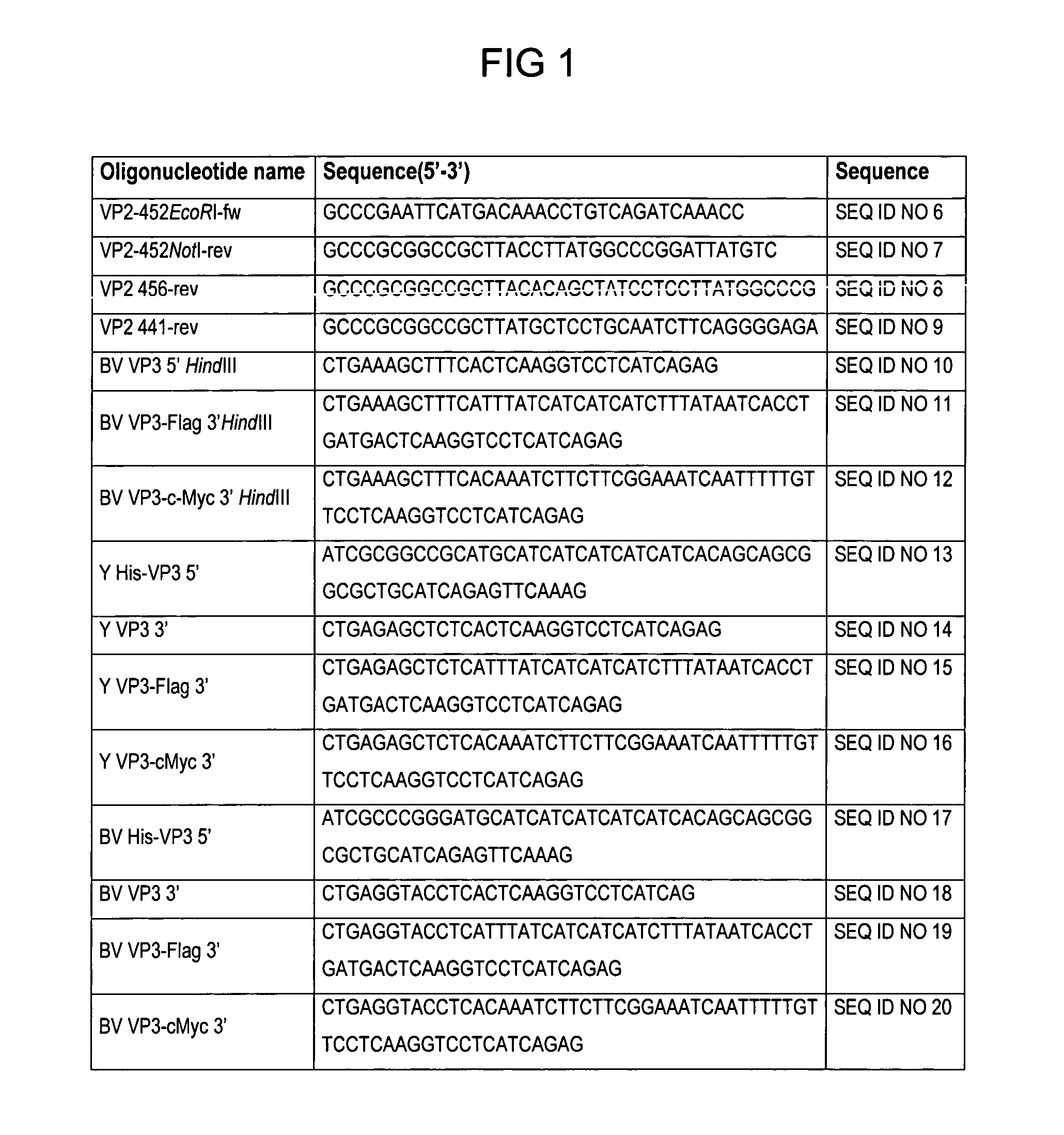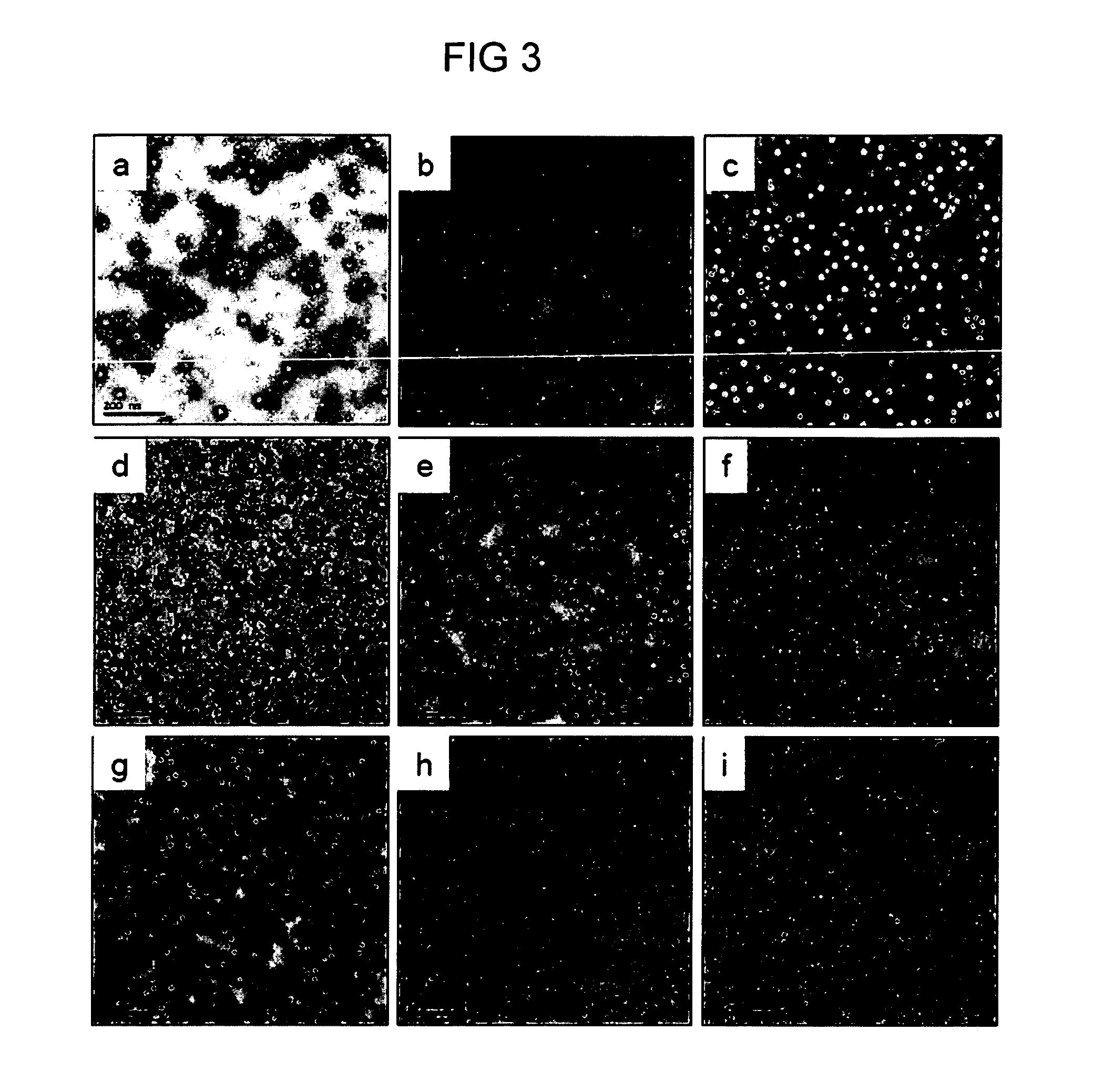Chimeric fusion proteins and virus like particles from birnavirus vp2
a technology of birnavirus and fusion proteins, which is applied in the field of birnavirus vp2 fusion proteins and virus like particles, can solve the problems of inability of the resulting chimeric vp2 protein to self-assemble in the form of vlp, and the restriction of the insertion or substitution of vlp based on ibdv vp2 insertions or substitutions
- Summary
- Abstract
- Description
- Claims
- Application Information
AI Technical Summary
Benefits of technology
Problems solved by technology
Method used
Image
Examples
example 1
Insertion of Peptides of Interest in P Loop Regions of IBDV VP2
[0089]A collection of plasmids incorporating a SpeI site at each of the possible positions within the VP2 P loops, and immediately adjacent positions, was generated by site-directed mutagenesis using the yeast expression plasmid pESC-URA-VP2 452 (pESC-URA / VP2). For the construction of pESC-URA / VP2 the VP2 cDNA was amplified using oligonucleotides VP2-452EcoRI-fw (SEQ. ID. NO: 6) and VP2-452NotI-rev (SEQ. ID. NO: 7) (FIG. 1) and templates pESC-URA / pVP2-512 which contains full-length IBDV VP2 512 insert (IBDV Soroa strain, NCIB No. AAD30136). The VP2 452 I nsert was coned into EcoRI and NotI digested pESC-URA (Stratagene™) in which SpeI site was previously deleted. The insertion of the SpeI restriction site generated a Serine-Threonine (TS) insertion at each of the possible positions within the VP2 P loop regions as shown in Table 1 and exemplified for P loop region DE in FIG. 2. Purified SpeI-VP2 loop insertion vectors (V...
example 2
Insertion of Peptides of Interest in P Loop Regions of VP2 of Different Lengths
[0092]To test if the length of VP2 proteins could affect VLP formation efficiency, IBDV VP2 of different lengths at their C-terminal, namely VP2 with 452, 441 and 456 amino acids (VP2 452, VP2 441 and VP2 456), were compared for their capacity to incorporate insertions of peptides of interest, namely cMyc (SEQ. ID. NO: 3) and Flag (SEQ. ID. NO: 2), in locations within P loop regions DE and HI. For the construction of pESC-URA / VP2 456 and pESC-URA / VP2 441 the VP2 cDNA was amplified using oligonucleotides VP2 452EcoRI-fw (SEQ. ID. NO: 6) and VP2 456-rev (SEQ. ID. NO: 8) or VP2 441-rev (SEQ. ID. NO: 9) and template pESC-URA / pVP2 512 which contains full-length VP2 512 insert. Purified VP2 456 and VP2 441 gene fragments were cloned into EcoRI and NotI digested plasmids pESC-URA / VP2 452. For this purpose VP2 loop insertion plasmids [e.g.: pESC-URA / VP2 (H253↑Flag↑G254), were digested with RsrII and MscI restrict...
example 3
Substitution of P Loop Regions for Peptides of Interest
[0094]To facilitate substitution of P loop regions by peptides of interest, cloning vectors were generated in which the codons within the P loop regions were replaced by a sequence encoding for a short linker containing a NotI restriction enzyme site using a pESC-URA / VP2 452 plasmid with a mutation in the NotI site downstream of the VP2 452 gene (pESC-URA / VP2 452 [ΔNotI]). In one series of mutants the entire P loop region was deleted and in another series all except the first and last codon of each P loop were deleted, as shown in Table 3. Example peptides of interest, namely Flag (SEQ. ID. NO: 2) and cMyc (SEQ. ID. NO: 3) were cloned following standard procedures as NotI dsDNA fragments for the DNA of interest into NotI linearised cloning vectors [e.g.: pESC-URA / VP2 / ΔY220-G223] generating in frame insertions. Purified constructs [e.g.: pESC-URA / VP2 / ΔY220-G223 / Q219↑Flag↑G224 were used to transform S. cerevisiae Y449 and the VLP ...
PUM
| Property | Measurement | Unit |
|---|---|---|
| length | aaaaa | aaaaa |
| chemical | aaaaa | aaaaa |
| symmetry | aaaaa | aaaaa |
Abstract
Description
Claims
Application Information
 Login to View More
Login to View More - R&D
- Intellectual Property
- Life Sciences
- Materials
- Tech Scout
- Unparalleled Data Quality
- Higher Quality Content
- 60% Fewer Hallucinations
Browse by: Latest US Patents, China's latest patents, Technical Efficacy Thesaurus, Application Domain, Technology Topic, Popular Technical Reports.
© 2025 PatSnap. All rights reserved.Legal|Privacy policy|Modern Slavery Act Transparency Statement|Sitemap|About US| Contact US: help@patsnap.com



